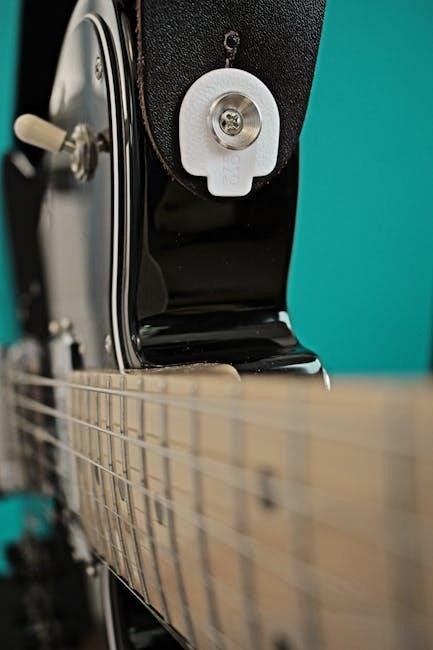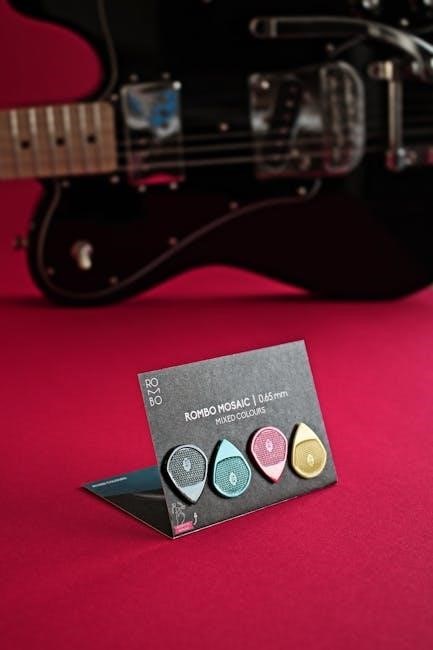
electric guitar strings guide
Electric guitar strings offer a wide range of options, from materials like nickel-plated steel to stainless steel, and varying gauges that impact tone, playability, and overall performance.

Overview of Electric Guitar Strings
Electric guitar strings come in various materials, such as nickel-plated steel, stainless steel, and pure nickel, each offering distinct tonal qualities. String gauge, measured in thousandths of an inch, affects playability and tension, with lighter gauges being easier for beginners. Wound strings provide warmth and sustain for lower pitches, while plain strings deliver clarity for higher notes. Proper maintenance, like regular cleaning, is essential for preserving tone and extending string life. Understanding these basics helps guitarists choose the right strings to enhance their sound and performance.
Importance of Choosing the Right Strings
Choosing the right electric guitar strings is crucial for optimal playability, tone, and performance. The correct gauge and material ensure proper tension, preventing discomfort and potential damage to the guitar. Strings significantly impact the overall sound quality, with different materials offering unique tonal characteristics. Properly suited strings also enhance durability, reducing the frequency of replacements. Additionally, they influence the guitar’s action and intonation, ensuring smooth playing and consistent pitch accuracy. Selecting the right strings tailors the instrument to the player’s style and preferences, making it essential for achieving desired results.

Types of Electric Guitar Strings
Electric guitar strings vary by material, gauge, and winding, offering options like nickel-plated, stainless steel, coated, and flatwound, each providing unique tones and playability.
Nickel-Plated Steel Strings
Nickel-plated steel strings are a popular choice, offering a balanced tone with warmth and clarity. The nickel plating provides a smooth playing feel and resistance to corrosion, making them durable. These strings are versatile, suitable for rock, blues, and jazz, and are known for their sustain and articulation. They strike a great balance between brightness and warmth, making them ideal for players seeking a classic electric guitar sound. Their versatility and reliability make them a favorite among many musicians across various genres.
Pure Nickel Strings
Pure nickel strings are favored for their warm, vintage tone and smooth playing feel. Made from 100% nickel windings, they produce a rich, full sound with excellent sustain. These strings are ideal for blues, jazz, and classic rock, offering a balanced response across all frequencies. The nickel material reduces finger noise and provides a softer touch compared to steel-based strings. While they may corrode slightly faster, their tone remains consistent over time, making them a great choice for players seeking a nostalgic, warm sound with minimal brightness.
Stainless Steel Strings
Stainless steel strings are known for their bright, crisp tone and exceptional durability. They resist corrosion well, ensuring a long-lasting, consistent sound. The steel windings provide a smooth playing feel despite their robust construction. These strings are ideal for aggressive playing styles and genres like metal and hard rock, where clarity and sustain are crucial. While they may feel slightly stiffer than nickel-based strings, their tone remains vibrant and articulate, making them a great choice for players seeking a balance of tone and resilience.
Coated Strings (E.g., Elixir Nanoweb)
Coated strings, like Elixir Nanoweb, feature a thin protective layer that reduces corrosion and finger noise. This coating preserves tone clarity and ensures strings feel smooth and quiet under the fingers. They are ideal for players seeking long-lasting performance, as the coating minimizes dirt and oil buildup. Coated strings are slightly more expensive but offer extended playability and consistent sound quality. Nanoweb, in particular, is praised for its thin coating that maintains a natural feel while enhancing string life.

String Gauge and Its Impact
String gauge significantly impacts playability, tone, and tuning stability. Lighter gauges offer easier bending and faster action, while heavier gauges provide fuller tone and better sustain.
What is String Gauge?
String gauge refers to the thickness of guitar strings, measured in thousandths of an inch. It ranges from light (e.g., 0.010 ー 0.046) to heavy (e.g., 0.012 ー 0.054). Thicker strings produce fuller tones and better sustain but are harder to bend, while lighter strings are easier to play but lack depth. Gauge affects playability, tone, and tuning stability, making it crucial for matching your playing style and musical genre. The right gauge ensures optimal performance and comfort for guitarists.
Light Gauge Strings (0.010 ー 0.046)
Light gauge strings (0.010 ー 0.046) are ideal for players seeking ease of playability and bright, articulate tones. These strings are easier to bend and fret, making them perfect for lead guitar, solos, and fast-paced playing styles. They produce less sustain but offer crisp clarity, suitable for genres like rock, blues, and jazz. However, they may lack the depth and warmth of heavier gauges and are more prone to breakage under heavy use. Light gauges are great for beginners or those prioritizing comfort and agility.
Medium Gauge Strings (0.011 ー 0.052)
Medium gauge strings (0.011 ー 0.052) offer a balanced blend of playability and tone, making them a popular choice for many players. They provide a full, rich sound with good sustain while maintaining a comfortable feel. These strings are versatile, suitable for various genres like rock, blues, and jazz. They strike a nice balance between ease of bending and a robust tone. While slightly stiffer than light gauges, they remain manageable for most players. Medium gauges are ideal for those seeking a mix of clarity and warmth without sacrificing comfort or performance.
Heavy Gauge Strings (0.012 ー 0.054)
Heavy gauge strings (0.012 — 0.054) deliver powerful, full-bodied tone with increased sustain, making them ideal for heavy genres like metal and hard rock. Their thicker construction provides a robust sound but can feel stiffer, requiring more finger strength. These strings are great for palm muting, chunky riffs, and drop tunings. However, they may cause increased fret buzz if the guitar isn’t properly set up. Players with stronger hands often prefer heavy gauges for their durability and aggressive tone, though they can be challenging for beginners due to the higher tension.

String Materials and Tone
String materials significantly impact tone, with nickel, steel, and coated options offering distinct warmth, brightness, and sustain. Material choice tailors the sound to suit various playing styles and genres;
Nickel-Wound vs. Steel-Wound Strings
Nickel-wound strings deliver a warm, vintage tone with smooth playability, ideal for jazz and blues. Steel-wound strings offer a bright, crisp sound with increased sustain, perfect for rock and metal. Nickel strings have a softer feel, while steel strings provide a sharper attack and durability. Players choose based on tone preferences and genre demands, balancing warmth and brightness for their sound.
Wound vs. Plain Strings
Wound strings feature a wire wrapped around a core, offering a warmer, richer tone with more sustain, ideal for lower pitches. Plain strings are single strands of metal, delivering a bright, crisp sound suited for higher pitches. Wound strings provide smoother playability and are typically used for E, A, D, G strings, while plain strings are used for B, e. The choice depends on tone preference, genre, and playability needs.
Material Effects on Tone (Warmth vs. Brightness)
String materials significantly influence tone, with nickel-plated strings offering warmth and vintage character, while stainless steel strings provide brightness and clarity. Pure nickel strings enhance midrange warmth, ideal for jazz, whereas coated strings like Elixir Nanoweb balance warmth and brightness. The material’s interaction with pickups and playing style determines the overall sound. Players seeking a classic, mellow tone often choose nickel, while those preferring sharp, articulate notes opt for stainless steel or coated options, allowing for versatility across genres and musical styles. Experimentation is key to finding the perfect tone.

String Windings and Coatings
String windings affect playability and tone, with smooth options reducing fret wear. Coatings, like Nanoweb, extend life and maintain tone by resisting corrosion and dirt.
Roundwound vs. Flatwound Strings
Roundwound strings feature a rounded wire wrapped around the core, offering a bright, crisp tone with good sustain. They are versatile and suit most genres. Flatwound strings have a smooth, flat wire wrapping, producing a warm, mellow tone with less finger noise. They are ideal for jazz and smooth playing styles, reducing fretboard wear. Roundwounds are more common, while flatwounds are preferred for their silky feel and sustain. Both cater to different musical needs, with roundwounds excelling in clarity and flatwounds in smoothness.
Coated vs. Uncoated Strings
Coated strings feature a thin layer of material, like polymer or ceramic, wrapping the windings to reduce corrosion and extend lifespan. They provide a smoother feel, less finger noise, and resistance to sweat and dirt. Uncoated strings, lacking this layer, offer a brighter, more natural tone but are prone to oxidization. Coated strings are ideal for players seeking durability and low maintenance, while uncoated strings suit those prioritizing raw tone and classic feel. Both options cater to different preferences, balancing tone, playability, and longevity.
Benefits of Coated Strings
Coated strings offer extended lifespan due to their protective layer, resisting corrosion and dirt buildup. This results in consistent tone and reduced string changes. The coating minimizes finger noise, providing a smoother playing experience. Additionally, coated strings are more resistant to sweat and humidity, making them ideal for active performers. While they may slightly alter tone, the trade-off in durability and maintenance makes them a practical choice for many players seeking long-lasting performance and reduced upkeep.
Choosing Strings by Genre
Choosing the right strings by genre ensures optimal tone and performance. Rock, metal, blues, jazz, and alternative each require specific string types and gauges for desired results.
Strings for Rock and Metal
Rock and metal guitarists often prefer heavy gauge strings (0.011 — 0.052 or higher) for their durability and sustain. These genres demand bright, aggressive tones, making stainless steel or nickel-plated steel strings ideal. Heavy gauges withstand intense playing styles, such as palm muting and aggressive bending. Brands like Ernie Ball and D’Addario offer sets tailored for metal, with enhanced clarity and resistance to corrosion. Coated strings, like Elixir, can also be a good choice for their longevity and smooth playability under heavy use.
Strings for Blues and Jazz
Blues and jazz players often favor lighter to medium gauge strings (0.010, 0.046) for their smooth playability and rich, warm tones. Nickel-wound or pure nickel strings are popular for their vintage, articulate sound. Flatwound strings are also a great choice, as they reduce finger noise and offer a smooth feel, ideal for intricate phrasings. Coated strings, such as Elixir, provide longevity while maintaining clarity. Brands like D’Addario and Ernie Ball offer sets tailored for these genres, ensuring optimal balance between warmth and responsiveness.
Strings for Punk and Alternative
Punk and alternative guitarists often prefer medium to heavy gauge strings (0.011 ー 0.052) for their bold, aggressive sound and durability. Nickel-plated steel or stainless steel strings are popular for their bright, punchy tone, which cuts through distortion. Lighter gauges (0.010 ー 0.046) are also used for faster playing styles. Coated strings, like Elixir, resist sweat and grime, while flatwound strings reduce finger noise for smoother rhythms. Brands like Ernie Ball and D’Addario offer sets tailored for these genres, delivering the energy and edge needed for dynamic performances.

String Maintenance and Longevity
Regular cleaning, proper storage, and avoiding moisture help extend string life. These practices prevent grime buildup and corrosion, ensuring optimal tone and playability over time.
How to Clean Guitar Strings
Cleaning guitar strings regularly helps maintain their tone and longevity. Use a soft, dry cloth to wipe down the strings, removing dirt and oils. For deeper cleaning, lightly dampen the cloth with water or use a guitar string cleaner. Avoid harsh chemicals or excessive moisture, as they can damage the strings. After cleaning, dry the strings thoroughly with a clean cloth. Regular cleaning prevents grime buildup and corrosion, ensuring optimal playability and sound quality over time.
Best Practices for String Care
Proper string care extends their lifespan and maintains tone. Avoid exposure to sweat and moisture by wiping strings after play. Store your guitar in a dry, cool environment to prevent corrosion. Handle strings gently to avoid kinks or damage. Play with clean, dry hands to reduce oil and dirt transfer. Regularly check for signs of wear, like rust or fraying. Change strings every 3-4 months or when tone dulls. These habits ensure optimal performance and longevity of your electric guitar strings.
When to Change Strings
Determining when to change electric guitar strings depends on usage and condition. Replace them every 3-4 months or after 100 hours of playtime. Look for signs like corrosion, dull tone, or uneven playability. If strings feel sticky or intonation issues arise, it’s time to change. New strings enhance clarity and sustain. For gigging musicians, fresh strings before performances ensure optimal sound. Clean strings regularly to extend lifespan, but when wear is evident, replacement is best.

Budget and Brand Considerations
Electric guitar strings vary in price, offering options for every player.
Brands like Ernie Ball and D’Addario provide quality choices.
Premium strings often feature advanced materials and coatings for improved tone.
Affordable vs. Premium Strings
Affordable electric guitar strings are a great option for beginners or casual players, offering decent tone and playability at a lower cost. They are often made with nickel-plated steel and machine-wound for consistency. Premium strings, while pricier, provide enhanced sustain, brightness, and durability due to high-quality materials like pure nickel or stainless steel. Brands like Ernie Ball offer affordable options, while Elixir Strings are known for their premium, long-lasting coated strings. Choosing between them depends on your budget, playing frequency, and tone preferences.
Popular Brands (E.g., Ernie Ball, D’Addario)
When it comes to electric guitar strings, certain brands stand out for their quality and reputation. Ernie Ball is a household name, famous for their Slinky strings, which are favored by countless guitarists for their bright tone and durability. D’Addario is another leading brand, known for consistent quality and innovative designs, such as their XL series. Both brands offer a wide range of gauges and materials, catering to different playing styles and musical genres. Their commitment to excellence ensures optimal tone and longevity for players of all levels.
Brand-Specific Features and Innovations
Different brands offer unique features that cater to specific player needs. Ernie Ball’s Slinky strings are renowned for their balanced tone and durability, while D’Addario’s XL series provides enhanced brightness and longevity. Elixir Strings introduced Nanoweb coatings, reducing finger noise and extending string life. Some brands, like DR Strings, use proprietary materials for distinct tonal qualities. These innovations allow players to choose strings tailored to their genre, playing style, and sound preferences, ensuring optimal performance and versatility.

Installation and Setup
Proper installation and setup of electric guitar strings are crucial for optimal playability and sound quality. This process involves carefully winding strings, cutting excess, and tuning accurately. Using the right tools, like string cutters and a tuner, ensures smooth setup. Adjusting the bridge and nut for proper string action improves playing comfort and prevents buzzing. Regularly checking and maintaining string tension helps sustain tuning stability and prolongs string life.
How to String an Electric Guitar
To string an electric guitar, start by loosening the old strings completely. Remove the old strings from the bridge and tuning pegs. Install the new string, threading it through the bridge and winding it around the tuning peg. Use a string winder for efficiency. Cut excess string with clippers and stretch the strings to prevent tuning issues. Tune the guitar and repeat the stretching process. Finally, check the action and intonation to ensure proper playability. This process ensures smooth setup and optimal performance.
Adjusting Action and Intonation
Adjusting the action (string height) and intonation ensures optimal playability and tone. Start by measuring the action at the 12th fret using a ruler, aiming for 4/64″ on the low E and 3/64″ on the high E. Use the bridge or individual saddles to lower or raise strings. For intonation, tune the open string, then fret the 12th fret and adjust the saddle until the fretted note matches the open string. Repeat for all strings, ensuring accuracy across the fretboard. Proper setup enhances performance and tone consistency.
String Stretching Techniques
String stretching is essential for stabilizing tuning and ensuring optimal playability. Start by holding the guitar by the neck and gently pulling each string away from the fretboard, stretching it evenly across its length. Focus on the higher strings, as they tend to stretch more. Repeat this process several times, tuning the guitar after each stretch. For tremolo systems, use the whammy bar to simulate bends, helping the strings settle. Consistent stretching reduces tuning issues during performances or practice.
Advanced Considerations
Exploring custom string sets, alternative tunings, and gauge combinations can unlock unique tones. Players can mix gauges for optimal playability and sound, tailored to their style.
Custom String Sets
Custom string sets allow players to tailor their tone and feel by selecting specific gauges for individual strings. This approach is ideal for musicians with unique playing styles or tonal preferences. For example, combining lighter gauges on higher strings for bending with heavier gauges on lower strings for tighter bass response. Custom sets are particularly popular among experienced players seeking precision and consistency. However, they may require more effort to install and can be more expensive than standard sets. Experimentation is key to finding the perfect balance.
Alternative Tunings and String Choices
Exploring alternative tunings can significantly impact your sound, and choosing the right strings is crucial. For example, tunings like Drop D or Open G benefit from slightly heavier gauges to maintain clarity and avoid floppiness. Heavier strings provide better tension for lower pitches, ensuring consistent tone. Players often opt for mixed sets, combining heavier bass strings with lighter trebles. Experimenting with string materials, such as nickel or stainless steel, can also enhance the desired tonal characteristics. Adjusting your string selection based on tuning can elevate your playing experience and sound quality.
Experimenting with Different Gauges
Experimenting with different gauges allows players to tailor their tone and playing experience. Lighter gauges (0.010-0.046) offer easier bending and a brighter sound, ideal for lead work. Heavier gauges (0.012-0.054) provide more sustain and a warmer, fuller tone, often preferred for rhythm and heavier genres. Players can mix gauges to balance playability and tone. Testing various sets helps identify the perfect feel and sound for individual styles. Start with a gauge close to your current setup and adjust gradually to find your ideal balance.
Selecting the right electric guitar strings is crucial for your sound and playing experience. Experiment with different gauges and materials to find your perfect tone and enjoy the journey of creating music.
Final Tips for Selecting Strings

When choosing electric guitar strings, consider your playstyle, genre, and tone preferences. Experiment with different gauges and materials to find the perfect balance. Lighter gauges are ideal for bending and fast play, while heavier gauges offer sustain and stability. Coated strings can extend life but may alter tone. Maintain your strings by cleaning regularly and changing them every 100 hours of play. Trust your ears—tone is subjective. Don’t overspend; focus on quality within your budget. The right strings will enhance your playing experience.
Encouragement to Experiment
Experimenting with different electric guitar strings is key to discovering your unique sound. Don’t be afraid to try various gauges, materials, and brands to find what resonates with your playing style. Every string set offers a distinct tone and feel, so keep an open mind. Whether you’re a seasoned pro or a beginner, this journey of exploration will enhance your musical journey. Embrace the process, and remember, the right strings can elevate your performance and inspire creativity.
Keep experimenting—your perfect sound awaits!


Leave a Reply
You must be logged in to post a comment.